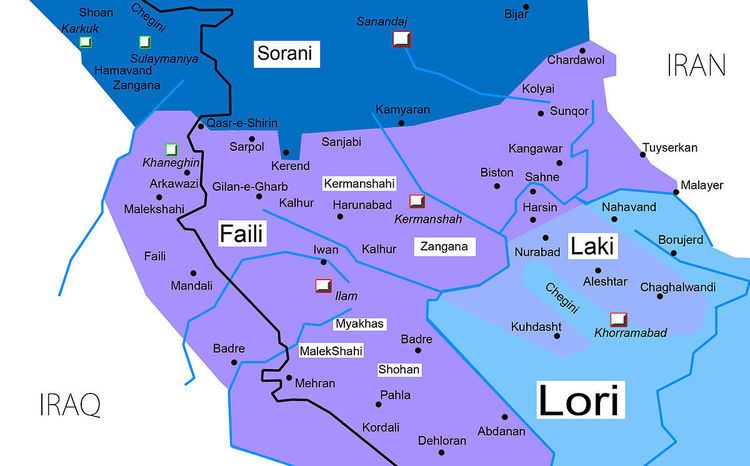 | ||
Feyli Lurs, Feyli Kurds or Feylis (Feyli Lurish: لوره یل فه یلی) are a part of Lur people mainly live in Lorestan, Kermanshah and Ilam. The Safavid era historian, Mirza Muhammad Husein Mostowfi (1749 A.D), classified Feyli alongside Laki, Bakhtiari and Mamasani as four subgroup of Lurish people. Austen Henry Layard (1887) described Feylis as the largest and the most powerful of Lur tribes inhabiting the mountains to the north of Dezful. Lurish is related to Indo Iranian language. Feyli lurs in Iraq live mainly in Maysan, Diyala, Wasit.
Contents
Etymology
The territory inhabited by the Pahli/Fayli people was known as "Pahla" (meaning "Parthia") since the 3rd century AD, outside proper Parthia (or Khorasan Province) in Iran. The name "Pahla" was also used for the area by the early Muslims until the 13th century. Lurs have later captured the region of Ilam (old name: Pahlah) to replace it to Lorestan. Nowadays, Pahleh is a city in Ilam Province.
Ethnogenesis
Feyli Lurs are a community living in Baghdad and the Diyala Province of Iraq around Mandali, and across the Iranian border, mainly in the provinces of Luristan and south of Ilam. The Fayli are an important community within the wider luri people. Faylee (Faylee, Faili, or Feli) Iraqi Lurs are part of the Lurish population in Iraq and an integral part of the Lurish nation, though others believe they are much more related to Persians. Faylee have themselves shown, over the years, and still show this fact and reality by words and deeds. They speak Feyli, a dialect that belongs to the Lurish language. Feyli is spoken particularly on both sides of the border areas between Iraq and Iran. In addition to their Feyli Lurish dialect, a special Lurish clothing distinguishes Feyli Lurs from other Lurish subgroups.
Since ancient times, the Feylis have lived in the border area between Iraq and Iran, which consists of both sides of the Zagros Mountains, which they call it Kabir Kuh, "the great mountain". The areas on the Iraqi side from north to south are the following: some parts of Shahraban (now called Miqdadiyah), Khaneqin, Mandali, Badrah, Zurbatiyah, Gassan, Al–Kut and Al-Azizyah. They also reside in a number of cities in the area of Shaikh Sa’ad, Ali Al Sharqi, Ali Al-Garbi and Al–Kufa, which is 170 kilometres (110 mi) south of Baghdad. However, as early as the first decade of the 20th century, many Feylis moved to Baghdad and lived in its center. Consequently, there are some areas which are named after them, such as the Kurdish quarter, the Kurdish alley, and the Kurdish Street.On the Iranian side, the Feylis live in the following areas, from north to south: Kermanshah, Qasr-e Shirin, Eslamabad-e Gharb, Gilan Gharb, Eyvan, Sirvan, Chardavol, Ilam, Chavar, Badreh, Dehloran, Abdanan, Darreh Shahr, Meymeh, Pahleh .
Historic roots of the Feylis
The roots of the Feyli go back to the Parthian/Pahlawi/Pahlawanid settlements of the 2nd century BC. Archaeological evidence from the Ilam Province in Iran indicates that some proportions of Fayli might have been Nestorian Christians until the 18th century. The conversion to Shia form of Islam seem to have begun under the Safavid dynasty (1507–1721) of Persia/Iran, Faylis today are primarily Imami Shias like the Persians, kurds and the Azeris, as well as the majority of the Iraqi Arabs.
Contemporary history of Feylis
In modern times the Feylis have been subject to state persecution. They are considered as a stateless people, with both Iran and Iraq claiming they are citizens of the other country. In the mid 1970s, Iraq expelled around 40,000 Feyli's who had lived for generations near Baghdad and Khanaqin, alleging that they were Iranian nationals.
